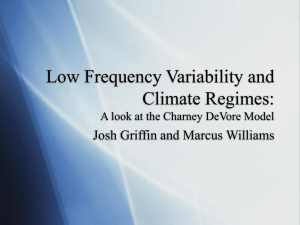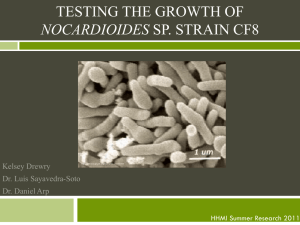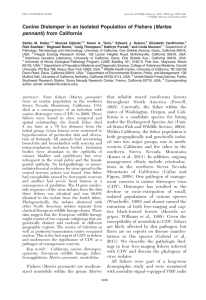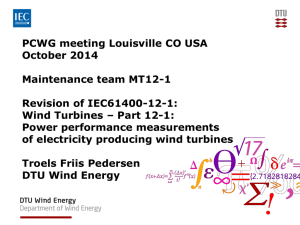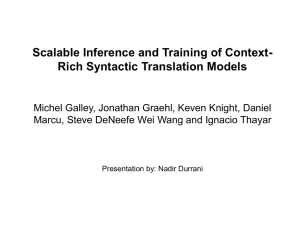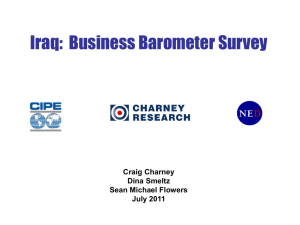Charney DeVore model
advertisement
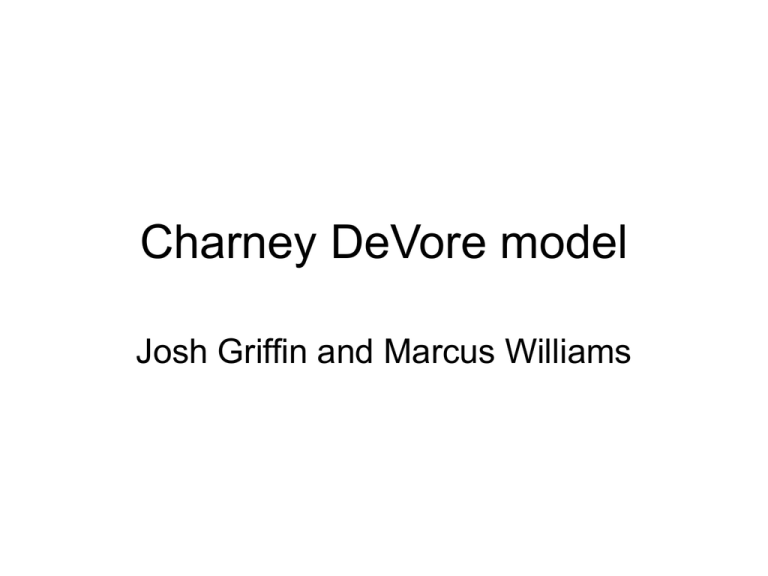
Charney DeVore model Josh Griffin and Marcus Williams Outline Introduction • Jule Charney is a well known scientist who has made multiple contributions to NWP including the Charney model. • Charney developed a set of equations for calculating the large-scale motions of planetary-scale waves known as the "quasi-geostrophic approximation • John DeVore Introduction • Charney and DeVore examined the concept of multiple flow equilibria in the atmosphere and blocking • CDV analyzed a simple model of a barotropic atmosphere in which an externally forced zonal flow interacts non-linearly with topography and with externally forced wave perturbations • Model hoped to describe the persistence of large amplitude flow anomalies like blocking or the recurring regional weather patterns. • Since the motions are large scale, they will be quasi-geostrophic and governed by the conservation of potential vorticity(PV) Introduction • Solutions to model yield two stable equilibria points and one unstable, transitional equilibria point. • The first stable equilibrium point is characterized as low-index, strong wave component with weak zonal flow (blocking) • The second stable equilibrium point is characterized as high-index, weak wave component with strong zonal flow. • There are several ways the model can be derived but we will focus on two derivations in particular. CDV derivation • The CDV model comprises a Rossby wave mode and uniform zonal flow over a mountain in a plane channel. • The coriolis parameter f is approximated by f = f + y • The flow is resticted by lateral walls with width 0< y<Lx and length 0<x<Lx. • The flow is also periodic in longitude so (x,y,t)= (x+Lx,y,t) Boundary conditions • No normal transport at the boundaries requires PHI to be constant at y= 0,Ly CDV Derivation • The equation used in the model is the QGPV equation 2 h D 2 J , 2 f o y f o E 2 * t H 2H • To derive the low order spectral model you must expand , , and h(x,y) into orthonormal eigenfunctions of the Leplace operator. * • This derivation is very complex. I will show a more general representation by solving Leplace’s equation on a rectangle and introducing the concept of orthogonality. CDV Derivation • Laplace equation 2u 2u u x 2 y 2 • Break the problem into four problems with each having one homogeneous condition • Separate the variables • Solve x dependent equation and y dependent equation. • Use boundary conditions and orthogonality to find coefficients CDV derivation • Orthogonality – Whenever 0 A( x) B( x)dx 0 it is said that functions are orthogonal over the interval 0<x<L. The term is borrowed from perpendicular vectors because the integral is analogous to a zero dot product L • n x m x 0 mn sin dx 0 L L L / 2 m n L n x m x 0 mn cos cos dx 0 L L L / 2 m n 0 L sin CDV Derivation • The process is similar in the derivation of the CDV model • First you have to non-dimensionalize the QGPV equation.(A1,A2) • Represent h(x,y) and PHI* in terms of sines and cosines(A3), and expand PHI into three orthonormal modes(A4). CDV derivation • Insert A3 and A4 back into the A1. • This leads to the following equations known as the CDV equations. • The CDV equations are solved to find the equilibrium points CDV model • As we found from holton, the system has three equilibria point. One unstable and two stable(Show graphic again?) • For arbitrary initial conditions the phase space trajectories always tend to one of the two stable equilibria • This is a drawback of the CDV model because there is no way to transition between the two stable equilibra points. CDV model
